Assessment of the Rice Panicle Initiation by Using NDVI-Based Vegetation Indexes
Abstract
:1. Introduction
2. Materials and Methods
2.1. Field Experiment Design and Management
2.2. Determination of PI through Dissection
2.3. Spectral Measurement and NDVI Calculations
2.4. Reference Wavelengths and Recombined NDVI-Based VIs
2.5. Estimation of PI Occurrence through First-Order Differentiation
2.6. Temperature and Growing Degree-Days (GDD)
2.7. Statistical Analysis
3. Results and Discussion
3.1. PI Determination through Manual Dissection
3.2. NDVI-Based VIs Selection
3.3. Estimation of PI Occurrence through First-Order Differentiation
3.4. Leave-One-Out (LOO) Cross-Validation
4. Conclusions
Author Contributions
Funding
Institutional Review Board Statement
Informed Consent Statement
Data Availability Statement
Acknowledgments
Conflicts of Interest
References
- Ghaley, B.B. Uptake and utilization of 5-split nitrogen topdressing in an improved and a traditional rice cultivar in the Bhutan Highlands. Exp. Agric. 2012, 48, 536–550. [Google Scholar] [CrossRef]
- Inamura, T.; Hamada, H.; Iida, K.; Umeda, M. Correlation of the amount of nitrogen accumulated in the aboveground biomass at panicle initiation and nitrogen content of soil with the nitrogen uptake by lowland rice during the period from panicle initiation to heading. Plant Prod. Sci. 2003, 6, 302–308. [Google Scholar] [CrossRef] [Green Version]
- Turner, F.T.; Jund, M.F. Chlorophyll meter to predict nitrogen topdress requirement for semidwarf rice. Agron. J. 1991, 83, 926–928. [Google Scholar] [CrossRef]
- Counce, P.A.; Keisling, T.C.; Mitchell, A.J. A Uniform, Objective, and Adaptive System for Expressing Rice Development. Crop Sci. 2000, 40, 436–443. [Google Scholar] [CrossRef] [Green Version]
- Moldenhauer, K.; Counce, P.; Hardke, J. Rice growth and development. In Rice Production Handbook; Hardke, J., Ed.; University of Arkansas Division of Agriculture: Little Rock, AR, USA, 2001; Volume 192, pp. 7–14. [Google Scholar]
- Ellis, R.H.; Qi, A.; Summerfield, R.J.; Roberts, E.H. Rates of leaf appearance and panicle development in rice (Oryza sativa L.): A comparison at three temperatures. Agric. For. Meteorol. 1993, 66, 129–138. [Google Scholar] [CrossRef]
- Gilmore, E.C.; Rogers, J.S. Heat units as a method of measuring maturity in corn. Agron. J. 1958, 50, 611–615. [Google Scholar] [CrossRef]
- Nielsen, D.; Hinkle, S. Field evaluation of basal crop coefficients for corn based on growing degree days, growth stage, or time. Trans. ASAE 1996, 39, 97–103. [Google Scholar] [CrossRef]
- Snyder, R.L.; Spano, D.; Cesaraccio, C.; Duce, P. Determining degree-day thresholds from field observations. Int. J. Biometeorol. 1999, 42, 177–182. [Google Scholar] [CrossRef]
- Angel, J.R.; Widhalm, M.; Todey, D.; Massey, R.; Biehl, L. The U2U corn growing degree day tool: Tracking corn growth across the US corn belt. Clim. Risk Manag. 2017, 15, 73–81. [Google Scholar] [CrossRef] [Green Version]
- Rouse, J.W.; Haas, R.H.; Schell, J.A.; Deering, D.W. Monitoring vegetation systems in the Great Plains with ERTS. NASA [Spec. Publ.] SP 1974, 351, 309. [Google Scholar]
- Tucker, C.J. Red and photographic infrared linear combinations for monitoring vegetation. Remote Sens. Environ. 1979, 8, 127–150. [Google Scholar] [CrossRef] [Green Version]
- Myneni, R.B.; Williams, D.L. On the relationship between FAPAR and NDVI. Remote Sens. Environ. 1994, 49, 200–211. [Google Scholar] [CrossRef]
- Gamon, J.A.; Field, C.B.; Goulden, M.L.; Griffin, K.L.; Hartley, A.E.; Joel, G.; Penuelas, J.; Valentini, R. Relationships between NDVI, canopy structure, and photosynthesis in three Californian vegetation types. Ecol. Appl. 1995, 5, 28–41. [Google Scholar] [CrossRef] [Green Version]
- Carlson, T.N.; Ripley, D.A. On the relation between NDVI, fractional vegetation cover, and leaf area index. Remote Sens. Environ. 1997, 62, 241–252. [Google Scholar] [CrossRef]
- Sims, D.A.; Gamon, J.A. Relationships between leaf pigment content and spectral reflectance across a wide range of species, leaf structures and developmental stages. Remote Sens. Environ. 2002, 81, 337–354. [Google Scholar] [CrossRef]
- Zhou, X.; Zheng, H.B.; Xu, X.Q.; He, J.Y.; Ge, X.K.; Yao, X.; Cheng, T.; Zhu, Y.; Cao, W.X.; Tian, Y.C. Predicting grain yield in rice using multi-temporal vegetation indices from UAV-based multispectral and digital imagery. ISPRS J. Photogramm. Remote Sens. 2017, 130, 246–255. [Google Scholar] [CrossRef]
- Tan, C.; Wang, D.; Zhou, J.; Du, Y.; Luo, M.; Zhang, Y.; Guo, W. Remotely assessing fraction of photosynthetically active radiation (FPAR) for wheat canopies based on hyperspectral vegetation indexes. Front. Plant Sci. 2018, 9, 776. [Google Scholar] [CrossRef] [PubMed] [Green Version]
- Gitelson, A.A.; Kaufman, Y.J.; Merzlyak, M.N. Use of a green channel in remote sensing of global vegetation from EOS-MODIS. Remote Sens. Environ. 1996, 58, 289–298. [Google Scholar] [CrossRef]
- Tanaka, S.; Kawamura, K.; Maki, M.; Muramoto, Y.; Yoshida, K.; Akiyama, T. Spectral index for quantifying leaf area index of winter wheat by field hyperspectral measurements: A case study in Gifu Prefecture, Central Japan. Remote Sens. 2015, 7, 5329–5346. [Google Scholar] [CrossRef] [Green Version]
- Yang, G.; Liu, J.; Zhao, C.; Li, Z.; Huang, Y.; Yu, H.; Xu, B.; Yang, X.; Zhu, D.; Zhang, X.; et al. Unmanned aerial vehicle remote sensing for field-based crop phenotyping: Current status and perspectives. Front. Plant Sci. 2017, 8, 1111. [Google Scholar] [CrossRef]
- Peng, S.; Buresh, R.J.; Huang, J.; Zhong, X.; Zou, Y.; Yang, J.; Wang, G.; Liu, Y.; Hu, R.; Tang, Q.; et al. Improving nitrogen fertilization in rice by sitespecific N management. A review. Agron. Sustain. Dev. 2010, 30, 649–656. [Google Scholar] [CrossRef]
- Xue, L.; Li, G.; Qin, X.; Yang, L.; Zhang, H. Topdressing nitrogen recommendation for early rice with an active sensor in south China. Precis. Agric. 2014, 15, 95–110. [Google Scholar] [CrossRef]
- Ali, A.M.; Thind, H.S.; Varinderpal, S.; Bijay, S. A framework for refining nitrogen management in dry direct-seeded rice using GreenSeeker™ optical sensor. Comput. Electron. Agric. 2015, 110, 114–120. [Google Scholar] [CrossRef]
- Onoyama, H.; Ryu, C.; Suguri, M.; Iida, M. Nitrogen prediction model of rice plant at panicle initiation stage using ground-based hyperspectral imaging: Growing degree-days integrated model. Precis. Agric. 2015, 16, 558–570. [Google Scholar] [CrossRef]
- Cao, Q.; Miao, Y.; Shen, J.; Yu, W.; Yuan, F.; Cheng, S.; Huang, S.; Wang, H.; Yang, W.; Liu, F. Improving in-season estimation of rice yield potential and responsiveness to topdressing nitrogen application with Crop Circle active crop canopy sensor. Precis. Agric. 2016, 17, 136–154. [Google Scholar] [CrossRef]
- Jiang, R.; Sanchez-Azofeifa, A.; Laakso, K.; Wang, P.; Xu, Y.; Zhou, Z.; Luo, X.; Lan, Y.; Zhao, G.; Chen, X. UAV-based partially sampling system for rapid NDVI mapping in the evaluation of rice nitrogen use efficiency. J. Cleaner Prod. 2021, 289, 125705. [Google Scholar] [CrossRef]
- Phyu, P.; Islam, M.R.; Sta Cruz, P.C.; Collard, B.C.Y.; Kato, Y. Use of NDVI for indirect selection of high yield in tropical rice breeding. Euphytica 2020, 216, 74. [Google Scholar] [CrossRef]
- Son, N.-T.; Chen, C.-F.; Chen, C.-R.; Guo, H.-Y.; Cheng, Y.-S.; Chen, S.-L.; Lin, H.-S.; Chen, S.-H. Machine learning approaches for rice crop yield predictions using time-series satellite data in Taiwan. Int. J. Remote Sens. 2020, 41, 7868–7888. [Google Scholar] [CrossRef]
- Wang, L.; Zhang, F.-C.; Jing, Y.-S.; Jiang, X.-D.; Yang, S.-B.; Han, X.-M. Multi-temporal detection of rice phenological stages using canopy spectrum. Rice Sci. 2014, 21, 108–115. [Google Scholar] [CrossRef]
- Yu, F.; Xu, T.; Cao, Y.; Yang, G.; Du, W.; Wang, S. Models for estimating the leaf NDVI of japonica rice on a canopy scale by combining canopy NDVI and multisource environmental data in Northeast China. Int. J. Agric. Biol. Eng. 2016, 9, 132–142. [Google Scholar]
- Zheng, H.; Cheng, T.; Li, D.; Yao, X.; Tian, Y.; Cao, W.; Zhu, Y. Combining unmanned aerial vehicle (UAV)-based multispectral imagery and ground-based hyperspectral data for plant nitrogen concentration estimation in rice. Front. Plant Sci. 2018, 9, 936. [Google Scholar] [CrossRef]
- Lu, J.; Miao, Y.; Shi, W.; Li, J.; Yuan, F. Evaluating different approaches to non-destructive nitrogen status diagnosis of rice using portable RapidSCAN active canopy sensor. Sci. Rep. 2017, 7, 14073. [Google Scholar] [CrossRef] [PubMed]
- Mahajan, G.R.; Pandey, R.N.; Sahoo, R.N.; Gupta, V.K.; Datta, S.C.; Kumar, D. Monitoring nitrogen, phosphorus and sulphur in hybrid rice (Oryza sativa L.) using hyperspectral remote sensing. Precis. Agric. 2017, 18, 736–761. [Google Scholar] [CrossRef]
- McMaster, G.S.; Wilhelm, W.W. Growing degree-days: One equation, two interpretations. Agric. For. Meteorol. 1997, 87, 291–300. [Google Scholar] [CrossRef] [Green Version]
- Jamieson, P.D.; Porter, J.R.; Wilson, D.R. A test of the computer simulation model ARCWHEAT1 on wheat crops grown in New Zealand. Field Crops Res. 1991, 27, 337–350. [Google Scholar] [CrossRef]
- Gammulla, C.G.; Pascovici, D.; Atwell, B.J.; Haynes, P.A. Differential proteomic response of rice (Oryza sativa) leaves exposed to high-and low-temperature stress. Proteomics 2011, 11, 2839–2850. [Google Scholar] [CrossRef]
- Liu, X.; Ferguson, R.B.; Zheng, H.; Cao, Q.; Tian, Y.; Cao, W.; Zhu, Y. Using an active-optical sensor to develop an optimal NDVI dynamic model for high-yield rice production (Yangtze, China). Sensors 2017, 17, 672. [Google Scholar] [CrossRef] [PubMed]
- Zhou, M.; Ma, X.; Wang, K.; Cheng, T.; Tian, Y.; Wang, J.; Zhu, Y.; Hu, Y.; Niu, Q.; Gui, L.; et al. Detection of phenology using an improved shape model on time-series vegetation index in wheat. Comput. Electron. Agric. 2020, 173, 105398. [Google Scholar] [CrossRef]
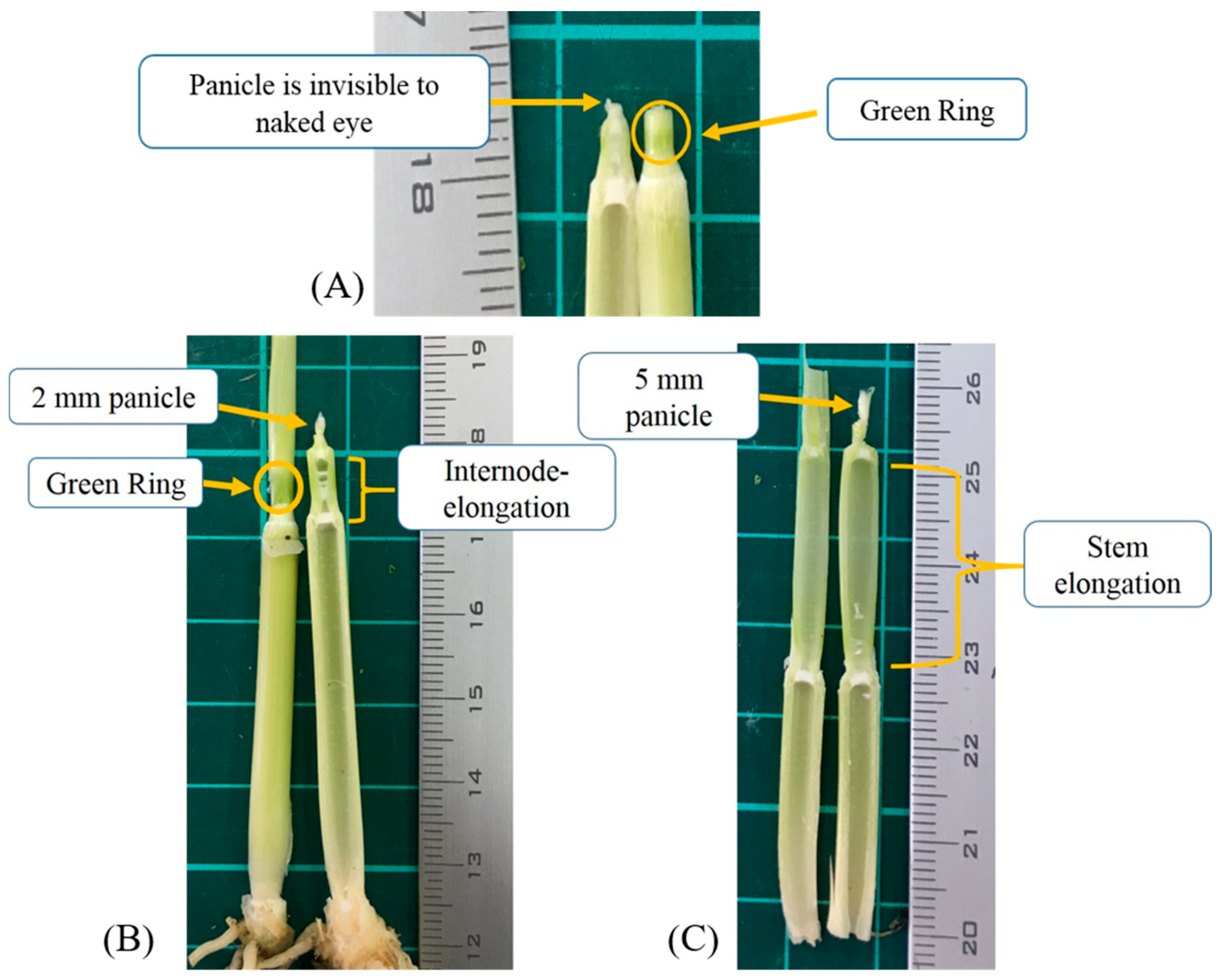
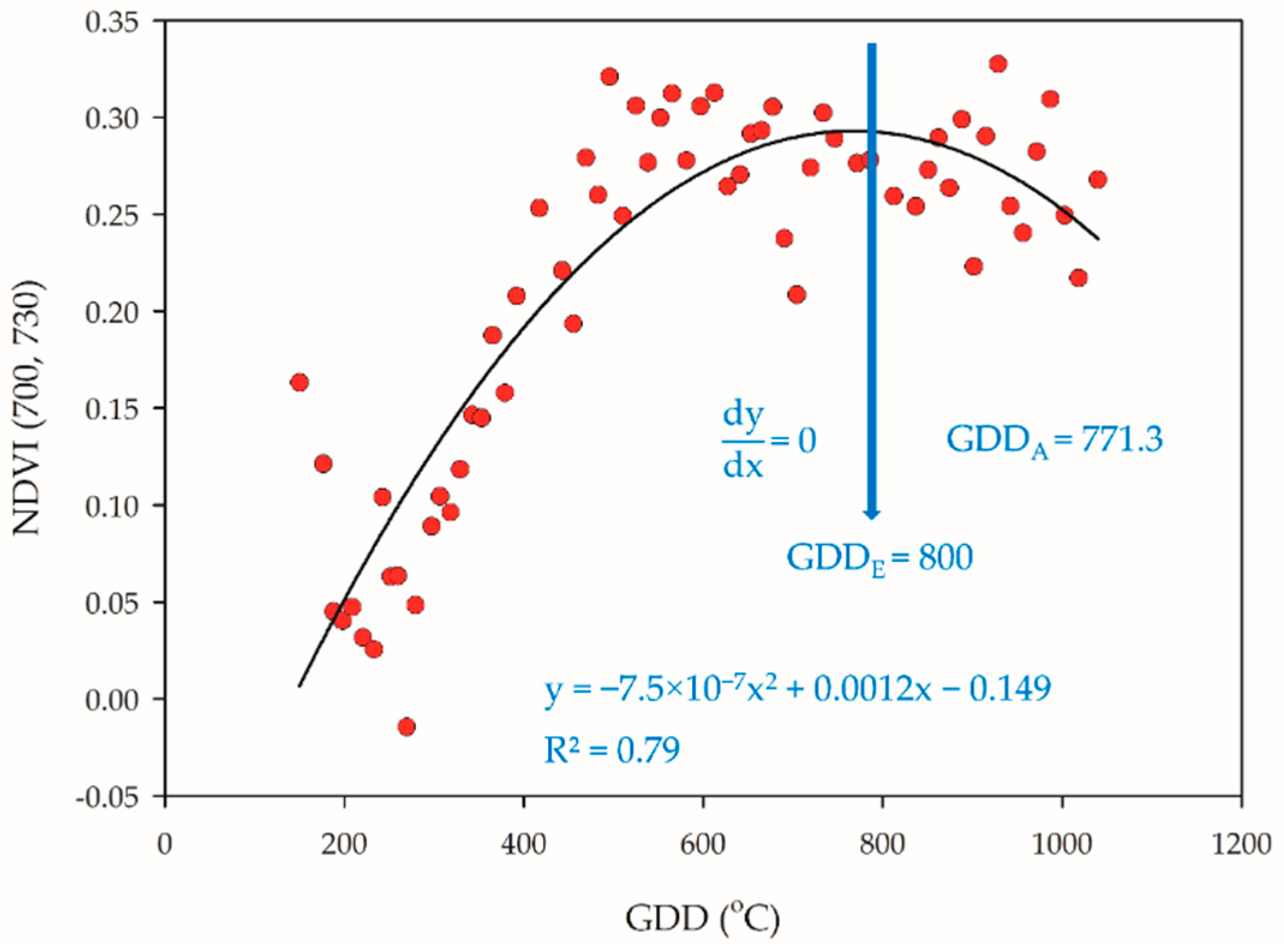
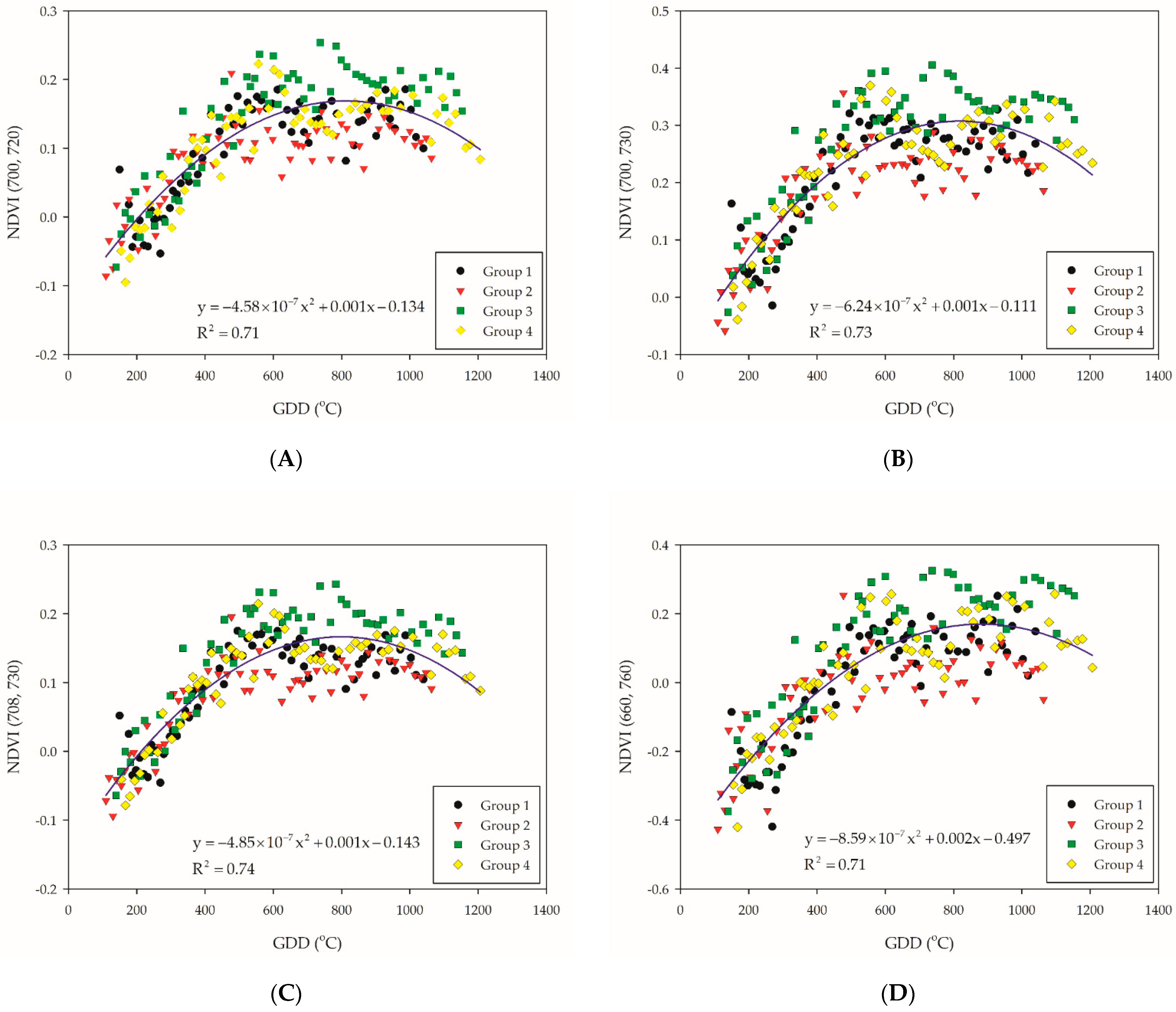
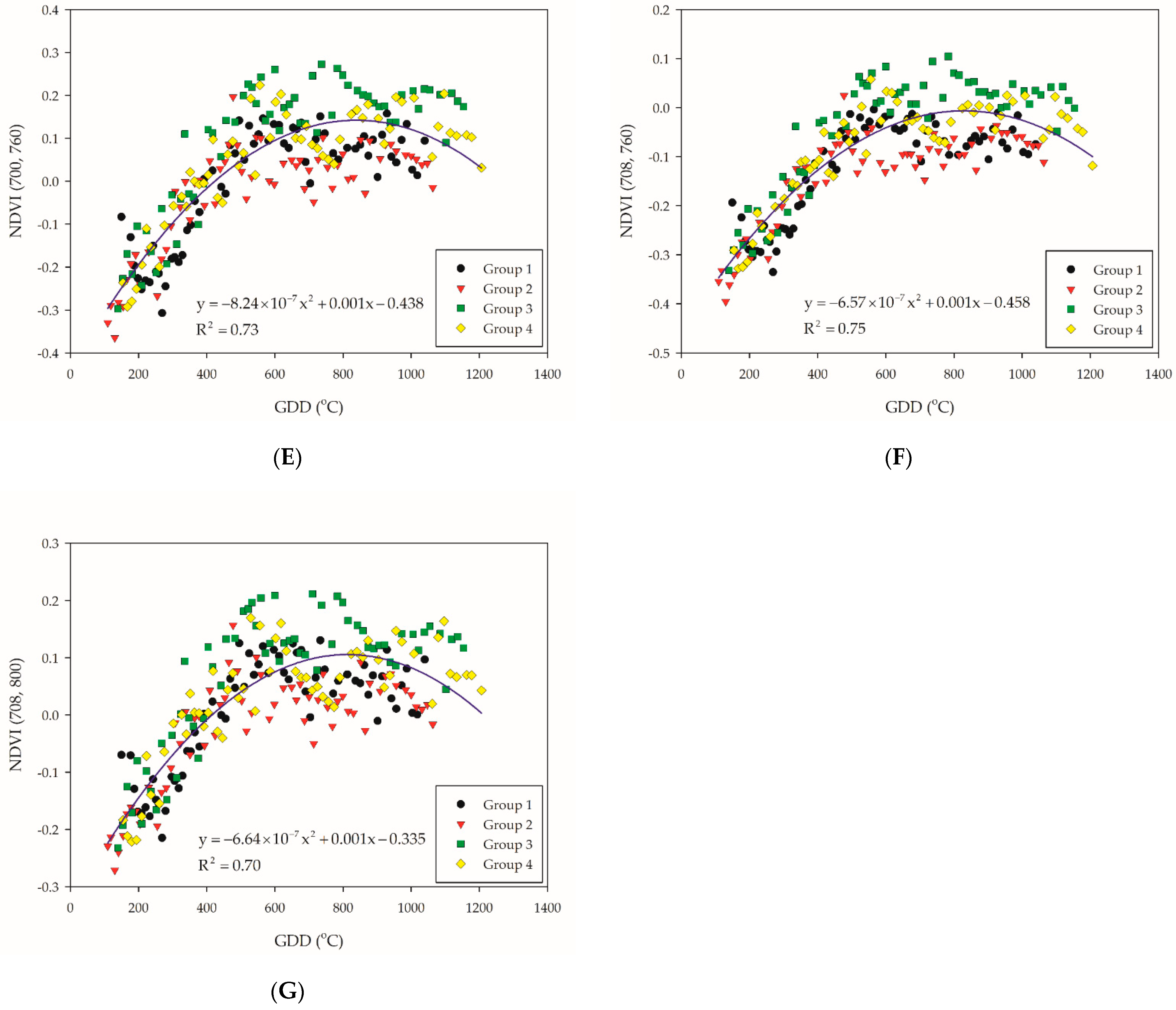
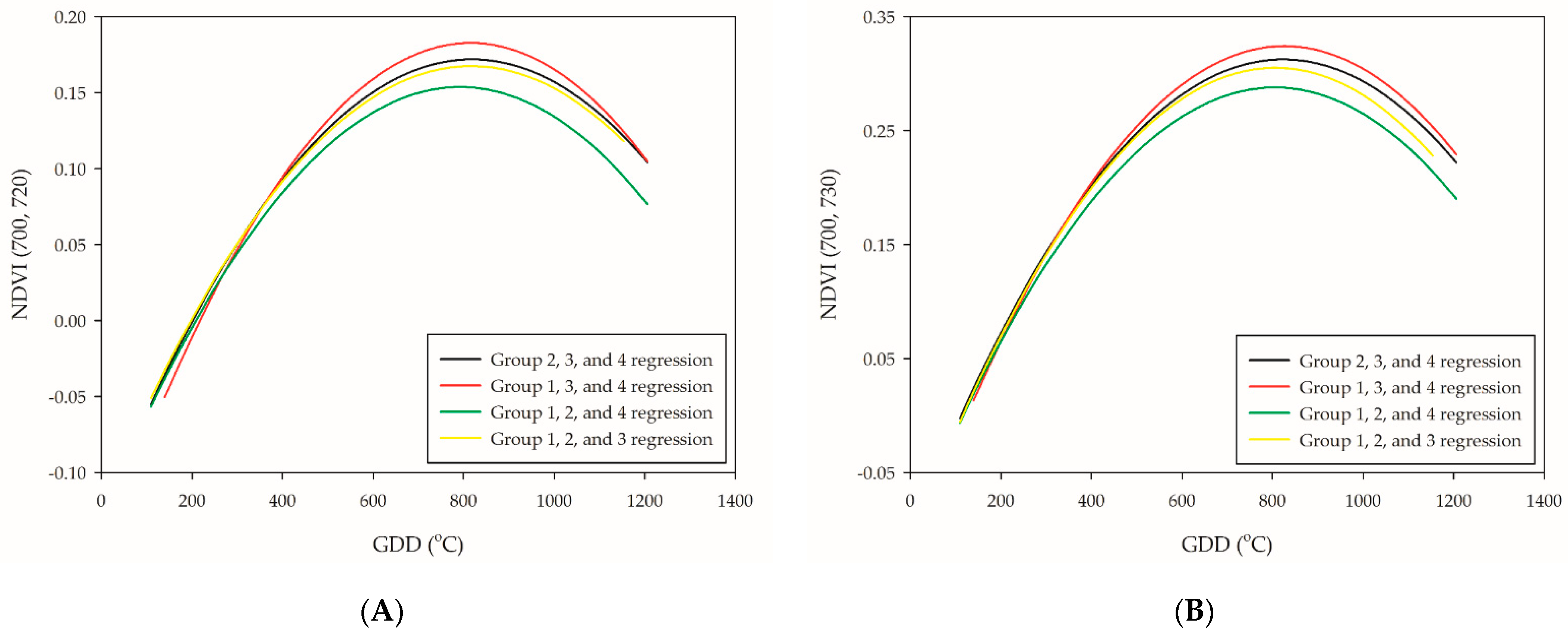

| Reference Wavelengths | Related Components | References |
|---|---|---|
| NDVI (720, 800) | LAI, yield | [17] |
| NDVI (708, 760) | Photosynthesis (FPAR) | [18] |
| NDVI (660, 740) | NDVIleaf and NDVIcanopy | [31] |
| NDVI (680, 800) | Plant N concentration; Chlorophyll content | [32] [16] |
| NDVI (670, 780) | Plant N concentration; Plant N uptake | [33] |
| 670, 700, 730 nm | N, P, S-related | [34] |
| Group | Date | DOY | DAT | GDD (°C) |
|---|---|---|---|---|
| 1 | 4 March 2019 | 63 | 60 | 771.3 |
| 2 | 14 March 2019 | 73 | 56 | 713.9 |
| 3 | 29 March 2019 | 88 | 57 | 783.4 |
| 4 | 10 April 2019 | 100 | 55 | 791.1 |
| 660 | 670 | 680 | 700 | 708 | 720 | 730 | 740 | 760 | 780 | 800 | ||
|---|---|---|---|---|---|---|---|---|---|---|---|---|
| 660 | ||||||||||||
| 670 | 0.24 | |||||||||||
| 680 | 0.31 | 0.47 | ||||||||||
| 700 | 0.37 | 0.33 | 0.38 | |||||||||
| 708 | 0.51 | 0.45 | 0.47 | 0.57 | ||||||||
| 720 | 0.62 | 0.58 | 0.60 | 0.71 | 0.58 | |||||||
| 730 | 0.68 | 0.64 | 0.65 | 0.73 | 0.74 | 0.55 | ||||||
| 740 | 0.67 | 0.64 | 0.64 | 0.68 | 0.69 | 0.43 | 0.29 | |||||
| 760 | 0.71 | 0.69 | 0.69 | 0.73 | 0.75 | 0.64 | 0.68 | 0.26 | ||||
| 780 | 0.66 | 0.64 | 0.64 | 0.66 | 0.66 | 0.43 | 0.34 | 0.41 | 0.00 | |||
| 800 | 0.67 | 0.65 | 0.65 | 0.68 | 0.70 | 0.49 | 0.43 | 0.37 | 0.10 | 0.10 | ||
| NDVI−Based VIs | Equation | Estimated GDDs | Actual GDDs | R2 | RE (%) |
|---|---|---|---|---|---|
| 700, 720 | y = −5.52 × 10−7x2 + 0.0008x − 0.161 | 724.6 | 771.3 | 0.77 | 5.82 |
| y = −4.15 × 10−7x2 + 0.0006x − 0.099 | 722.9 | 713.9 | 0.71 | ||
| y = −5.40 × 10−7x2 + 0.0009x − 0.160 | 833.3 | 783.4 | 0.85 | ||
| y = −5.29 × 10−7x2 + 0.0009x − 0.171 | 850.7 | 791.1 | 0.82 | ||
| 700, 730 | y = −7.50 × 10−7x2 + 0.0012x − 0.149 | 800 | 771.3 | 0.79 | 6.29 |
| y = −6.65 × 10−7x2 + 0.0010x − 0.100 | 751.9 | 713.9 | 0.77 | ||
| y = −7.44 × 10−7x2 + 0.0012x − 0.139 | 806.5 | 783.4 | 0.84 | ||
| y = −6.30 × 10−7x2 + 0.0011x − 0.125 | 873 | 791.1 | 0.8 | ||
| 708, 730 | y = −5.74 × 10−7x2 + 0.0009x − 0.162 | 784 | 771.3 | 0.79 | 6.23 |
| y = −4.45 × 10−7x2 + 0.0007x − 0.123 | 786.5 | 713.9 | 0.78 | ||
| y = −5.98 × 10−7x2 + 0.0010x − 0.171 | 836.1 | 783.4 | 0.88 | ||
| y = −5.16 × 10−7x2 + 0.0008x − 0.165 | 775.2 | 791.1 | 0.84 | ||
| 660,760 | y = −1.11 × 10−6x2 + 0.0018x − 0.608 | 810.8 | 771.3 | 0.8 | 10.38 |
| y = −9.10 × 10−7x2 + 0.0014x − 0.449 | 769.2 | 713.9 | 0.69 | ||
| y = −9.93 × 10−7x2 + 0.0018x − 0.530 | 906.3 | 783.4 | 0.84 | ||
| y = −9.20 × 10−7x2 + 0.0016x − 0.522 | 869.6 | 791.1 | 0.8 | ||
| 700, 760 | y = −1.03×10−6x2 + 0.0016x − 0.505 | 776.7 | 771.3 | 0.79 | 6.36 |
| y = −8.88 × 10−7x2 + 0.0013x − 0.435 | 732 | 713.9 | 0.79 | ||
| y = −1.00 × 10−6x2 + 0.0017x − 0.472 | 850 | 783.4 | 0.86 | ||
| y = −8.11 × 10−7x2 + 0.0014x − 0.435 | 863.1 | 791.1 | 0.82 | ||
| 708, 760 | y = −8.20×10−7x2 + 0.0012x − 0.504 | 731.7 | 771.3 | 0.8 | 5.63 |
| y = −6.41 × 10−7x2 + 0.0010x − 0.447 | 780 | 713.9 | 0.82 | ||
| y = −8.20 × 10−7x2 + 0.0013x − 0.491 | 792.7 | 783.4 | 0.89 | ||
| y = −6.71 × 10−7x2 + 0.0011x − 0.463 | 819.7 | 791.1 | 0.86 | ||
| 708, 800 | y = −8.24 × 10−7x2 + 0.0012x − 0.373 | 728.2 | 771.3 | 0.77 | 5.8 |
| y = −7.27 × 10−7x2 + 0.0011x − 0.341 | 756.5 | 713.9 | 0.78 | ||
| y = −8.48 × 10−7x2 + 0.0014x − 0.375 | 825.5 | 783.4 | 0.82 | ||
| y = −5.95 × 10−7x2 + 0.0010x − 0.320 | 840.3 | 791.1 | 0.75 |
| NDVI−Based VIs | Equation | Estimated GDDs | Actual | R2 | RE |
|---|---|---|---|---|---|
| GDDs | (%) | ||||
| 700, 720 | y = −4.51 × 10−7x2 + 0.0007x − 0.131 | 776.1 | 771.3 | 0.7 | 4.9 |
| y = −5.11 × 10−7x2 + 0.0008x − 0.157 | 782.8 | 713.9 | 0.77 | ||
| y = −4.51 × 10−7x2 + 0.0007x − 0.130 | 776.1 | 783.4 | 0.73 | ||
| y = −4.37 × 10−7x2 + 0.0007x − 0.124 | 800.9 | 791.1 | 0.68 | ||
| 700, 730 | y = −6.18 × 10−7x2 + 0.001x − 0.107 | 809.1 | 771.3 | 0.72 | 9.08 |
| y = −6.6 × 10−7x2 + 0.0011x − 0.127 | 833.3 | 713.9 | 0.77 | ||
| y = −6.08 × 10−7x2 + 0.001x − 0.107 | 822.4 | 783.4 | 0.75 | ||
| y = −6.40 × 10−7x2 + 0.001x − 0.111 | 781.3 | 791.1 | 0.71 | ||
| 708, 730 | y = −4.83 × 10−7x2 + 0.0008x − 0.143 | 828.2 | 771.3 | 0.74 | 5.76 |
| y = −5.26 × 10−7x2 + 0.0008x − 0.157 | 760.5 | 713.9 | 0.78 | ||
| y = −4.64 × 10−7x2 + 0.0007x − 0.137 | 754.3 | 783.4 | 0.77 | ||
| y = −4.83 × 10−7x2 + 0.0008x − 0.139 | 828.2 | 791.1 | 0.72 | ||
| 700,760 | y = −8.19 × 10−7x2 + 0.0014x − 0.430 | 854.7 | 771.3 | 0.73 | 12.3 |
| y = −8.65 × 10−7x2 + 0.0015x − 0.453 | 867.1 | 713.9 | 0.76 | ||
| y = −7.98 × 10−7x2 + 0.0013x − 0.433 | 814.5 | 783.4 | 0.76 | ||
| y = −8.55 × 10−7x2 + 0.0014x − 0.445 | 818.7 | 791.1 | 0.71 | ||
| 708, 760 | y = −6.59 × 10−7x2 + 0.0011x − 0.456 | 834.6 | 771.3 | 0.76 | 11.03 |
| y = −7.00 × 10−7x2 + 0.0012x − 0.471 | 857.1 | 713.9 | 0.77 | ||
| y = −6.28 × 10−7x2 + 0.001x − 0.453 | 796.2 | 783.4 | 0.78 | ||
| y = −6.7 × 10−7x2 + 0.0011x − 0.461 | 820.9 | 791.1 | 0.72 | ||
| 708, 800 | y = −6.61 × 10−7x2 + 0.0011x − 0.333 | 832.1 | 771.3 | 0.7 | 7.46 |
| y = −6.87 × 10−7x2 + 0.0011x − 0.342 | 800.6 | 713.9 | 0.72 | ||
| y = −6.26 × 10−7x2 + 0.0010x − 0.326 | 798.7 | 783.4 | 0.73 | ||
| y = −7.17 × 10−7x2 + 0.0011x − 0.345 | 767.1 | 791.1 | 0.69 |
Publisher’s Note: MDPI stays neutral with regard to jurisdictional claims in published maps and institutional affiliations. |
© 2021 by the authors. Licensee MDPI, Basel, Switzerland. This article is an open access article distributed under the terms and conditions of the Creative Commons Attribution (CC BY) license (https://creativecommons.org/licenses/by/4.0/).
Share and Cite
Lai, J.-K.; Lin, W.-S. Assessment of the Rice Panicle Initiation by Using NDVI-Based Vegetation Indexes. Appl. Sci. 2021, 11, 10076. https://doi.org/10.3390/app112110076
Lai J-K, Lin W-S. Assessment of the Rice Panicle Initiation by Using NDVI-Based Vegetation Indexes. Applied Sciences. 2021; 11(21):10076. https://doi.org/10.3390/app112110076
Chicago/Turabian StyleLai, Joon-Keat, and Wen-Shin Lin. 2021. "Assessment of the Rice Panicle Initiation by Using NDVI-Based Vegetation Indexes" Applied Sciences 11, no. 21: 10076. https://doi.org/10.3390/app112110076
APA StyleLai, J.-K., & Lin, W.-S. (2021). Assessment of the Rice Panicle Initiation by Using NDVI-Based Vegetation Indexes. Applied Sciences, 11(21), 10076. https://doi.org/10.3390/app112110076







